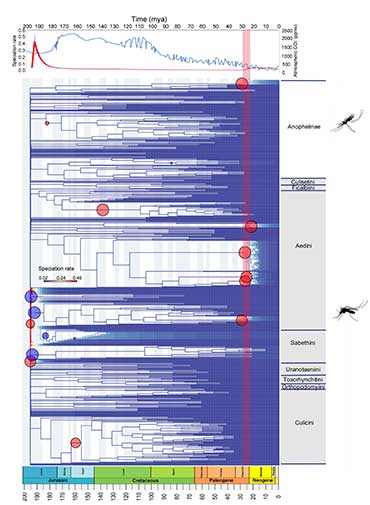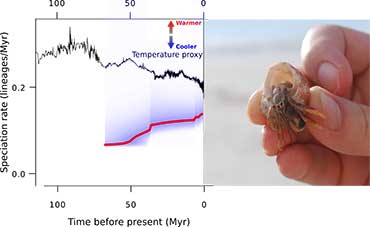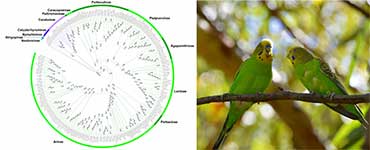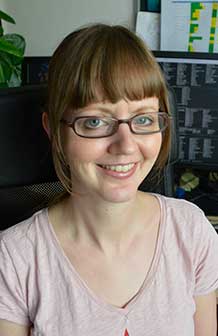Dr Katie E. Davis
Lecturer in Palaeobiology
Research
Research
Overview
I am an evolutionary palaeobiologist with a particular interest in the patterns and processes that led to the diversity of life we see on Earth today. My research aims to understand long-term patterns of biodiversity through the integration of macroevolution and macroecology over broad temporal and spatial scales. I use data from phylogeny, fossils and the geological record to investigate how biota have responded to environmental change through deep time and how this information can inform knowledge of extinction risk and potential biotic responses to climate change. I have a particular interest in vertebrates and coral reefs but work on a wide range of organisms and environments.
Beyond my immediate research area I am interested more broadly in many aspects of palaeobiology, ecology, evolution and conservation. Recent and current collaborations include projects on parrot conservation, dinosaur evolution, disparity methods in palaeobiology, and insect life histories.
Biodiversity change in the fossil record
Much of my research focuses on past biodiversity change, exploring the drivers of speciation and extinction over macroevolutionary timescales. In particular, I am interested in past climate change, ecological transitions, and biotic interactions as drivers of diversification.

Fig. 1: A phylogeny of mosquitoes showing that their speciation rate rapidly increased at about 30-24 million years ago, coincident with the radiation of mammals (red bar), which are their primary hosts (Tang et al., 2018).
The importance of fossils and the geological record
The geological record acts as a natural laboratory, providing information on the relationship between climate and biodiversity change. Only by looking at these past interactions can we better understand how human-induced climate change might be expected to further shape life on Earth. And if we want a full understanding of these past interactions we need to include fossils in phylogenies, as this is the only mechanism by which we see a clearer picture of past speciation and extinction in the absence of human activity.

Fig. 2: Left panel - Speciation rates for marine invertebrates (hermit crabs and their relatives) showing that global cooling drove increased diversification over macroevolutionary timescales in marine species (Davis et al., 2016). This has implications for future biodiversity in today’s rapidly warming world. Right panel – hermit crab in Antigua (photo credit: Katie Davis).
Numerical methods in evolution and palaeobiology
I am also interested in methods and numerical techniques in palaeobiology and phylogenetics. Previous work has included methods in constructing supertrees (large synthetic phylogenies) and methods of time-scaling phylogenies.

Fig. 3: Left panel - A supertree of parrots time-scaled using molecular dates (Burgio et al., 2019). Right panel – wild budgerigars in Carnarvon, Western Australia (photo credit: Jon Hill).
References
Burgio KR, Davis KE, Dreiss LM, Cisneros LM, Klingbeil BT, Presley SJ, Willig MR. 2019. Phylogenetic supertree and functional trait database for all extant parrots. Data in Brief 24: 103882.
Davis KE, Hill J, Astrop TI & Wills MA. 2016. Global cooling as a driver of speciation in a major marine clade. Nature Communications 7: 13003.
Tang C, Davis KE, Delmer C, Yang D & Wills MA. 2018. Elevated atmospheric CO2 correlates with increased rates of diversification in mosquitoes (Diptera, Culicidae). Communications Biology 1:182.
Teaching and scholarship
Teaching and scholarship
![]()
I teach in the areas of palaeobiology, ecology, evolution and numerical/computational biology. I aim to inspire and ignite interest in the natural world and in the patterns and processes that led to the diversity we see today. I encourage independent thinking and the development of critical thinking and problem solving skills. I like to challenge students by asking them to consider questions for which we do not necessarily have all the answers.
![]()
My tutorials are broadly about biological diversification and macroevolution. We explore topics on a broad temporal scale, from speciation in the geological record to extinction in the Anthropocene, and covering anything from mass extinctions and the history of life on Earth to the portrayal of climate-driven extinction in the media. The sessions are very much student-led and use a variety of activities to discuss and explore the topic; these include debates on controversial topics, presentations, posters and paper critiquing. These activities are all designed to develop independent thinking and study skills such as presenting, different types of writing, and critical thinking as well as an opportunity to engage more deeply with the topic.
![]()
Projects offered reflect my interest in vertebrate macroevolution and the impact of climate change and biotic interactions on the vertebrate tree of life. Potential groups that students might choose to work on include birds, dinosaurs, mammals, bony fish, sharks, reptiles and amphibians. Once a study group has been chosen students may choose to focus on hypotheses that explore the relationship between climate change and diversification, the impact of different methodologies, the utility of the fossil record, extinction risk in the Anthropocene. However, there is a lot of scope for individual interests to be accommodated. All projects are computational and offer the opportunity to develop data analysis skills. In addition, all projects address novel questions that have not yet been explored and therefore provide a real opportunity to contribute to scientific knowledge.

Contact details
Dr Katie E. Davis
Lecturer in Palaeobiology
B/C/104A
Department of Biology
University of York
Heslington
York
YO10 5DD
katie.davis@york.ac.uk
drkatiedavis.wordpress.com/
Communications Biology profile
